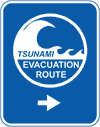Tsunami
Note: Newer information on this topic is available on the Get Ready website page - Tsunami.
![]()
New Zealand’s entire coast is at risk of tsunami. A tsunami can violently flood coastlines, causing devastating property damage, injuries and loss of life.
A tsunami is a natural phenomenon consisting of a series of waves generated when a large volume of water in the sea, or in a lake, is rapidly displaced. A tsunami can be caused by large submarine or coastal earthquakes; underwater landslides which may be triggered by an earthquake or volcanic activity; large coastal cliff or lakeside landslides; or volcanic eruptions beneath or near the sea.
The three types of tsunami
There are three distinct types of tsunami. The type you encounter depends on the distance you are from the place where it is generated.
- Distant tsunami are generated from a long way away, such as from across the Pacific in Chile. In this case, we will have more than three hours warning time for New Zealand.
- Regional tsunami are generated between one and three hours travel time away from their destination. An eruption from an underwater volcano in the Kermadec Trench to the north of New Zealand, could generate a regional tsunami.
- Local tsunami are generated very close to New Zealand. This type of tsunami is very dangerous because we may only have a few minutes warning.
TSUNAMI WARNINGS
Warning messages and signals about a possible tsunami can come from several sources – natural, official or unofficial.
Natural warnings
For a local source tsunami which could arrive in minutes, there won’t be time for an official warning. It is important to recognise the natural warning signs and act quickly.
See the right-hand panel for more information
Official warnings
Official warnings are only possible for distant and regional source tsunami. Official warnings are disseminated by the National Emergency Management Agency to the national media, local authorities and other key response agencies. Your local council may also issue warnings through local media, siren and other local arrangements.
Unofficial or informal warnings
You may receive warnings from friends, other members of the public, international media and from the internet. Verify the warning only if you can do so quickly. If official warnings are available, trust their message over informal warnings.
BEFORE A TSUNAMI

Getting ready before a tsunami strikes will help reduce damage to your home and business and help you survive.
- If you live in a coastal area, ask your council about your tsunami risk and local warning arrangements.
- If you have a disability or special requirements, arrange with your support network to alert you of any warnings and emergency broadcasts.
- Develop a Household Emergency Plan and have a Getaway Kit ready.
- Know where the nearest high ground is and how you will reach it. Plan to get as high up or as far inland as you can. Plan your escape route for when you are at home, as well as for when you may be working or holidaying near the coast.
DURING A TSUNAMI
- Take your getaway kit with you if possible. Do not travel into the areas at risk to get your kit or belongings.
- Take your pets with you if you can do so safely.
- Move immediately to the nearest higher ground, or as far inland as you can. If evacuation maps are present, follow the routes shown.
- Walk or bike if possible and drive only if essential. If driving, keep going once you are well outside the evacuation zone to allow room for others behind you.
- Boats are usually safer in water deeper than 20 metres than if they are on the shore. Move boats out to sea only if there is time and it is safe to do so.
- Never go to the shore to watch for a tsunami. Stay away from at-risk areas until the official all-clear is given.
- Listen to your local radio stations as emergency management officials will be broadcasting the most appropriate advice for your community and situation.
AFTER A TSUNAMI
- Continue to listen to the radio for civil defence advice and do not return to the evacuation zones until authorities have given the all-clear.
- Be aware that there may be more than one wave and it may not be safe for up to 24 hours, or longer. The waves that follow the first one may also be bigger.
- Check yourself for injuries and get first aid if needed. Help others if you can.
- Do not go sightseeing.
- When re-entering homes or buildings, use extreme caution as floodwaters may have damaged buildings. Look for, and report, broken utility lines to appropriate authorities.
- If your property is damaged, take notes and photographs for insurance purposes. If you rent your property, contact your landlord and your contents insurance company as soon as possible.
